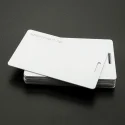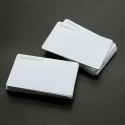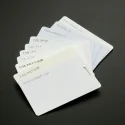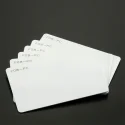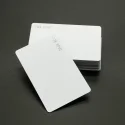13.56mhz ntag424dna tt RFID NFC PVC PC PLA Blank Card with Hole
| Product name | RFID card |
| Chip type | LF / HF / UHF Custom |
| Material | RPVC/ PVC/ PET/PC |
| Size | CR80 or Custom |
RFID cards are widly used in Access Control, Identification, Security, Cashless Payment, Time Attendance, Hotel, School, Club,Tourism, Health Care, Super Market, Parking, Promotions, Membership Management and EV Charging, etc. Material RPVC/PVC / PET/ABS
RFID cards are available in different frequency ranges, such as low frequency (LF), high frequency (HF), and ultra-high frequency (UHF). The specific frequency used depends on the application requirements, read range, and the compatibility of the reader and card.
125 kHz RFID card refers to a type of RFID card that operates on the 125 kHz frequency. These cards are commonly used for access control systems, identification purposes, and other applications that require proximity-based authentication.125 kHz RFID cards utilize proximity-based technology, also known as low-frequency (LF) RFID. The card needs to be in close proximity to the RFID reader (usually within a few centimeters) for communication to occur.
13.56 MHz RFID cards are often referred to as contactless smart cards. They contain an embedded microchip that can store and process data. These cards can support various applications, such as secure access control, payment systems, public transportation, loyalty programs, and identification.
13.56 MHz RFID cards often comply with industry standards such as ISO 14443 or ISO 15693. These standards define protocols for communication between the card and the reader, ensuring interoperability between different card and reader manufacturers.
UHF RFID cards can be read from a longer distance compared to LF (low-frequency) and HF (high-frequency) RFID cards. The read range can extend from a few meters up to several tens of meters, depending on the specific reader and environmental factors.
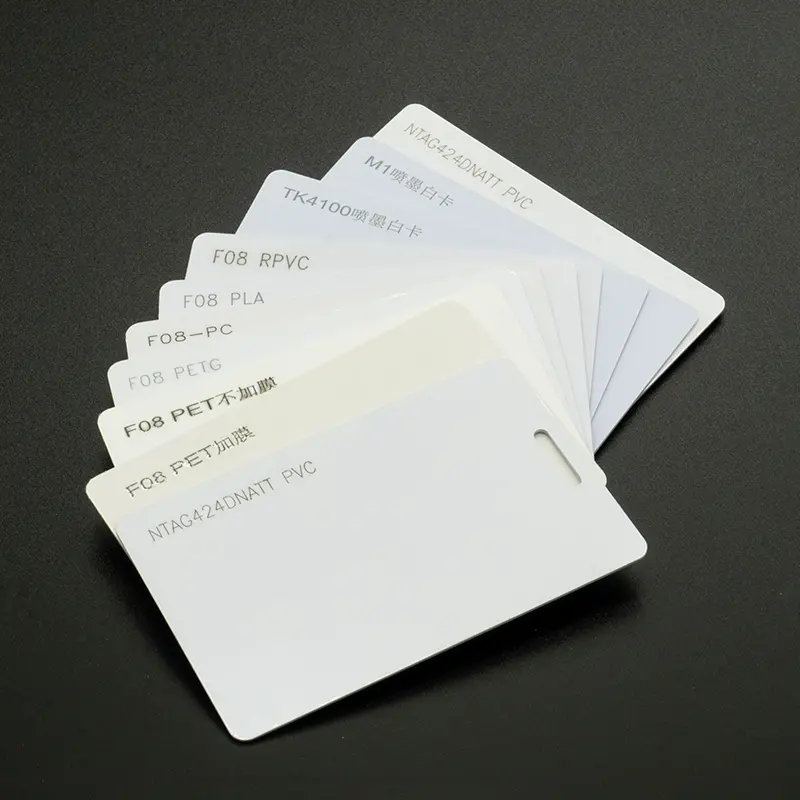
RFID cards offer a convenient and efficient way to identify, authenticate, and interact with various systems and applications without the need for physical contact. The specific features, capabilities, and compatibility of RFID cards may vary depending on the frequency, technology, and application requirements.
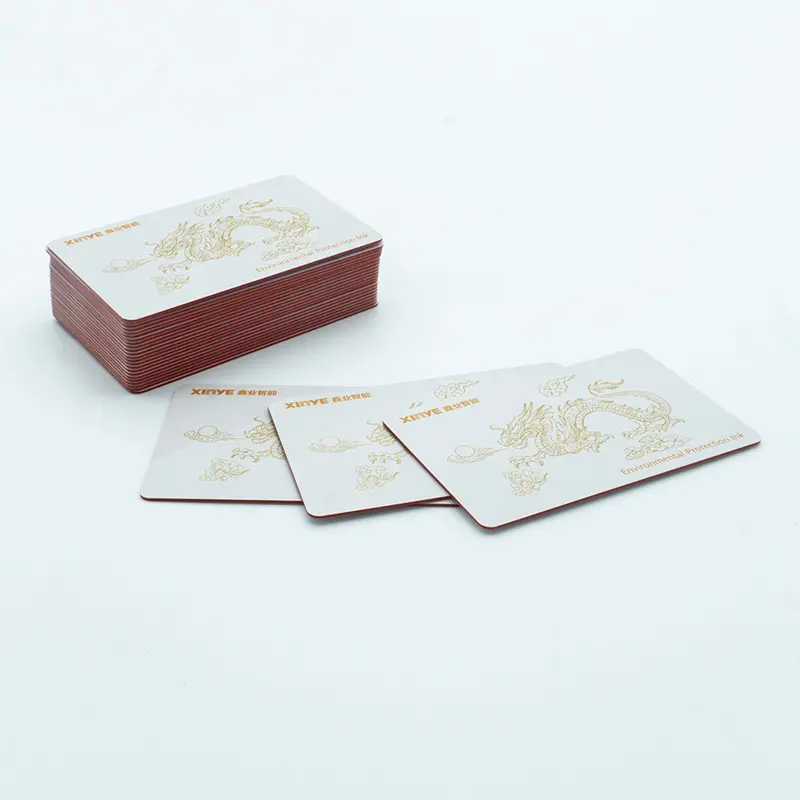
These cards are commonly used for access control systems, such as building entry, parking lot access, and secure areas. They are also used for identification purposes, membership cards, time and attendance tracking, and other applications that require proximity-based authentication.
| Material | RPVC/PVC / PET/ABS/PC/PLA/PETG |
| Size | 85.5*54mm as credit card (or customized size) |
| Thickness | 0.76mm/0.84mm/0.9mm(or customized) |
| Printing | CMYK Offset Printing / Silk screen printing/ Digital printing |
| Surface | Glossy, matt, frosted finish for choice |
| Personazation or special craft available for choice | Magnetic stripe: Loco 300oe, Hico 2750oe, 2 or 3 tracks, black/gold/silver mag |
| Barcode: 13 barcode, 128 barcode, 39 barcode, QR barcode, etc. | |
| Embossing numbers or letters in silver or gold color | |
| Metallic printing in gold or silver background | |
| Signature panel / Scratch-off panel | |
| Laser engraving numbers | |
| Gold/siver foil stamping | |
| UV spot printing | |
| Pouch round or oval hole | |
| Security printing: Hologram, OVI securiting printing, Braille, Fluorescent anti-counter feiting, Micro text printing | |
| Applications | Enterprises, school, club, advertising, traffic, super market, parking, bank, government, insurance, medical care, promotion, visiting etc. |
| Packing: | 200pcs/box, 10boxes/carton for standard size card or customized boxes or cartons as required |
| Leadtime | Normally 7-9 days after approval for standard printed cards |
| LF 125KHZ CHIP(portion) | |||
| Chip Name | Protocol | Capacity | Frequency |
| TK4100 | 64 bits | 125 kHz | |
| EM4200 | ISO 11784/11785 | 128 bits | 125 kHz |
| EM4205 | ISO 11784/11785 | 512bit | 125 kHz |
| EM4305 | ISO 11784/11785 | 512 bits | 125 kHz |
| EM4450 | ISO 11784/11785 | 1K | 125 kHz |
| T5577 | ISO 11784/11785 | 330 bits | 125 kHz |
| Atmel ATA5577 | ISO 11784/11785 | 363bit | 125 kHz |
| HITAG 1 | ISO 11784/11785 | - | 125 kHz |
| HITAG 2 | ISO 11784/11785 | - | 125 kHz |
| HITAG S256 | ISO 11784/11785 | - | 125 kHz |
| HITAG S2048 | ISO 11784/11785 | - | 125 kHz |
| HF 13.56 MHz Chips(portion) | |||
| Chip Name | Protocol | Capacity | Frequency |
| MIFARE Classic 1K | ISO14443A | 1 KB | 13.56 MHz |
| MIFARE Classic 4K | ISO14443A | 4 KB | 13.56 MHz |
| MIFARE Ultralight EV1 | ISO14443A | 80 byte | 13.56 MHz |
| MIFARE Ultralight C | ISO14443A | 192 byte | 13.56 MHz |
| MIFARE Classic S50 | ISO14443A | 1K | 13.56 MHz |
| MIFARE Classic S70 | ISO14443A | 4K | 13.56 MHz |
| MIFARE DESFire | ISO14444A | 2K/4K/8K bytes | 13.56MHz |
| ICODE SLIX | ISO15693 | 1024 bits | 13.56 MHz |
| ICODE SLI | ISO15693 | 1024bits | 13.56 MHz |
| ICODE SLI-L | ISO15693 | 512bits | 13.56 MHz |
| ICODE SLI-S | ISO15693 | 2048bit | 13.56 MHz |
| I CODE SLIX2 | ISO15693 | USER 2528bits | 13.56 MHz |
| NTAG210_212 | ISO14443A | 80/164bit | 13.56 MHz |
| NTAG213F_216F | ISO14443A | 180 bytes | 13.56 MHz |
| NTAG213 | ISO14443A | 180 bytes | 13.56 MHz |
| NTAG215 | ISO14443A | 540byte | 13.56MHz |
| NTAG216 | ISO14443A | 180 or 924 bytes | 13.56 MHz |
| NTAG213TT | ISO14443A | 180 bytes | 13.56 MHz |
| NTAG424 DNA TT | ISO14443A | 416 bytes | 13.56 MHz |
| NTAG203F | ISO14443A | 168byte | 13.56 MHz |
| 860-960MHz Chips(portion) | |||
| Chip Name | Protocol | Capacity | Frequency |
| Alien H3(Higgs 3) | ISO18000-6C | EPC 96-496bits、User 512bits | 860~960 MHz |
| Alien Higgs 4 | ISO18000-6C | EPC 128bits、User 128bits | 860~960 MHz |
| Impinj Monza 4 | ISO18000-6C | 96 bits | 860~960 MHz |
| Ucode 7 | ISO18000-6C | 128bits | 860~960 MHz |
| Ucode 8 | ISO18000-6C | EPC 128bits | 860~960 MHz |
| Ucode 8m | ISO18000-6C | EPC 96bits、User 32Bit | 860~960 MHz |
| Ucode 9 | ISO18000-6C | EPC 96bits、User 32Bits | 860~960 MHz |
| UCODE G2iL | ISO18000-6C | 128 bits | 860~960 MHz |
| U Code DNA | ISO18000-6C | EPC 128bits、User 3072Bits | 860~960 MHz |
| U Code HSL | ISO18000-6C | UID 8Bytes 、User 216Bytes | 860~960 MHz |
| Monza 4D | ISO18000-6C | EPC 128bits、User 32bits | 860~960 MHz |
| Monza 4QT | ISO18000-6C | 512bits | 860~960 MHz |
| Monza R6 | ISO18000-6C | 96bits | 860~960 MHz |
| Monza R6-P | ISO18000-6C | 32bits | 860~960 MHz |
| EM4124 | ISO18000-6C | 96bits | 860~960 MHz |
| EM4126 | ISO18000-6C | 208bit | 860~960 MHz |
| ME4423 | ISO18000-6C | User 160/64bits | 860~960 MHz |
| ICONDE and MIFARE Ultralight are registered trademarks of NXP B.V. and are used under license. | |||
In addition to 125khzd low frequency cards, we also have 13.56 MHz (high-frequency, HF) and UHF (ultra-high-frequency) RFID cards, which offer enhanced security and longer read ranges.
